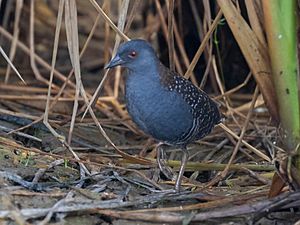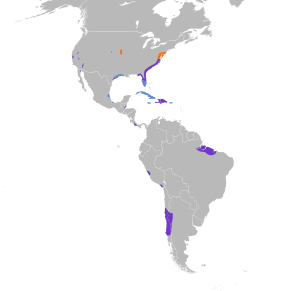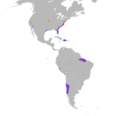Black rail facts for kids
Quick facts for kids Black rail |
|
|---|---|
 |
|
| Conservation status | |
| Scientific classification | |
| Genus: |
Laterallus
|
| Species: |
jamaicensis
|
 |
|
The black rail (Laterallus jamaicensis) is a tiny bird, about the size of a mouse! It belongs to a bird family called Rallidae, which includes other rails and coots. These small, secretive birds are hard to spot because they love to hide in dense marsh plants.
Contents
Meet the Black Rail Family
The black rail is part of a larger group of birds called Gruiformes. There are five different types, or subspecies, of black rails found around the world. Each one has slightly different features and lives in different places:
- Eastern Black Rail (L. j. jamaicensis): You can find this one in eastern North America, the Caribbean, and Central America. It's sometimes called the "feathered mouse"! These birds often move south for winter. In 2020, the US Fish and Wildlife Service said this subspecies is a threatened species, meaning it needs protection. You can tell them apart by their gray head and light brown neck.
- California Rail (L. j. coturniculus): This subspecies lives in California and Arizona, in both fresh and salty marshes. They stay in the same area all year. They have a shorter beak and a brown head and upper back. This type was listed as threatened in 1971 because their wetland homes were disappearing.
- Junín Rail (L. j. tuerosi): This rare rail lives only in the marshes around Lake Junín in Peru. Because they live in such a small area, they are considered endangered. They have plain feathers under their tail and pale legs.
- Peruvian Coastal Rail (L. j. murivagans): You can find this subspecies along the coast of Peru. They are generally paler than the others and have white stripes under their tail. Not much is known about this subspecies.
- Southern Black Rail (L. j. salinasi): This is the southernmost subspecies, found in Argentina and Chile. It's usually bigger than the other types and has a large reddish-brown patch on its upper back.
What Does a Black Rail Look Like?
The black rail is a small, dark bird with a short beak. They usually weigh about 29-39 grams (like a few pieces of candy!) and are 10-15 cm long. Their wings can spread about 22-28 cm wide.
Their bodies are mostly dark, with tiny white spots on their back and wings. Both their beak and legs are dark. When they are about three months old, their eyes turn a bright red color.
Their Special Call
You might not see a black rail often, but you might hear one! They make a unique "ki-ki-krr" sound. They also make an angry-sounding growl, especially when protecting their space. They are most vocal at night. The best time to hear them is in the first two weeks of May, when they are looking for mates and building nests.
Where Do Black Rails Live?
Black rails live in different places across North America, the Caribbean, and the Pacific coast of South America. They mostly prefer salty marshes near the coast, but some also live in freshwater marshes.
Sadly, these birds are disappearing or are already gone from many areas. This is mainly because their marsh homes are being destroyed. The largest groups of black rails in North America are found in Florida and California.
Black Rail Behavior
Black rails are very shy birds. They prefer to run and hide in the thick marsh plants rather than fly.
Building Nests and Raising Chicks
During the time they raise their young, black rails are very protective of their territory. Sometimes, a male black rail might mate with more than one female.
Their nests are built on the ground, hidden in dense, wet plants or flooded grass. The nests are shaped like a bowl and made from loosely woven plants.
A female black rail usually lays six to eight eggs. These eggs are creamy white with reddish-brown spots and are about 23 mm by 17 mm in size. Both parents take turns sitting on the eggs for about an hour each, for 16 to 20 days. When the chicks hatch, they are ready to move around soon after!
In 2015, cameras captured the first-ever black rail breeding in South Carolina. Before this, people thought these birds only visited the state and didn't raise families there.
What Do Black Rails Eat?
Black rails are not picky eaters! They eat many different things, including seeds, insects, small crabs, and snails. They often look for food along the water's edge after the tide goes in or out.
Why Are Black Rails in Danger?
The black rail is listed as an endangered species, which means their numbers are going down. Experts believe there are only about 28,000 to 92,000 adult black rails left. The biggest dangers to these birds are the loss of their homes and severe weather events like big storms.
Over the past few decades, many of the wetlands where black rails live have been drained. This happens when land is cleared for buildings or turned into farms.
Another problem is that it's hard to study black rails because they are so secretive. This means scientists don't have a lot of information about them, which makes it harder to help protect them.
Many animals hunt black rails, including other birds like hawks and egrets, and mammals like foxes and cats. Black rails rely on the thick marsh plants to hide from these predators. High tides can be very dangerous for them because they are more exposed when their marsh home is flooded.
Images for kids
See also
 In Spanish: Burrito cuyano para niños
In Spanish: Burrito cuyano para niños




